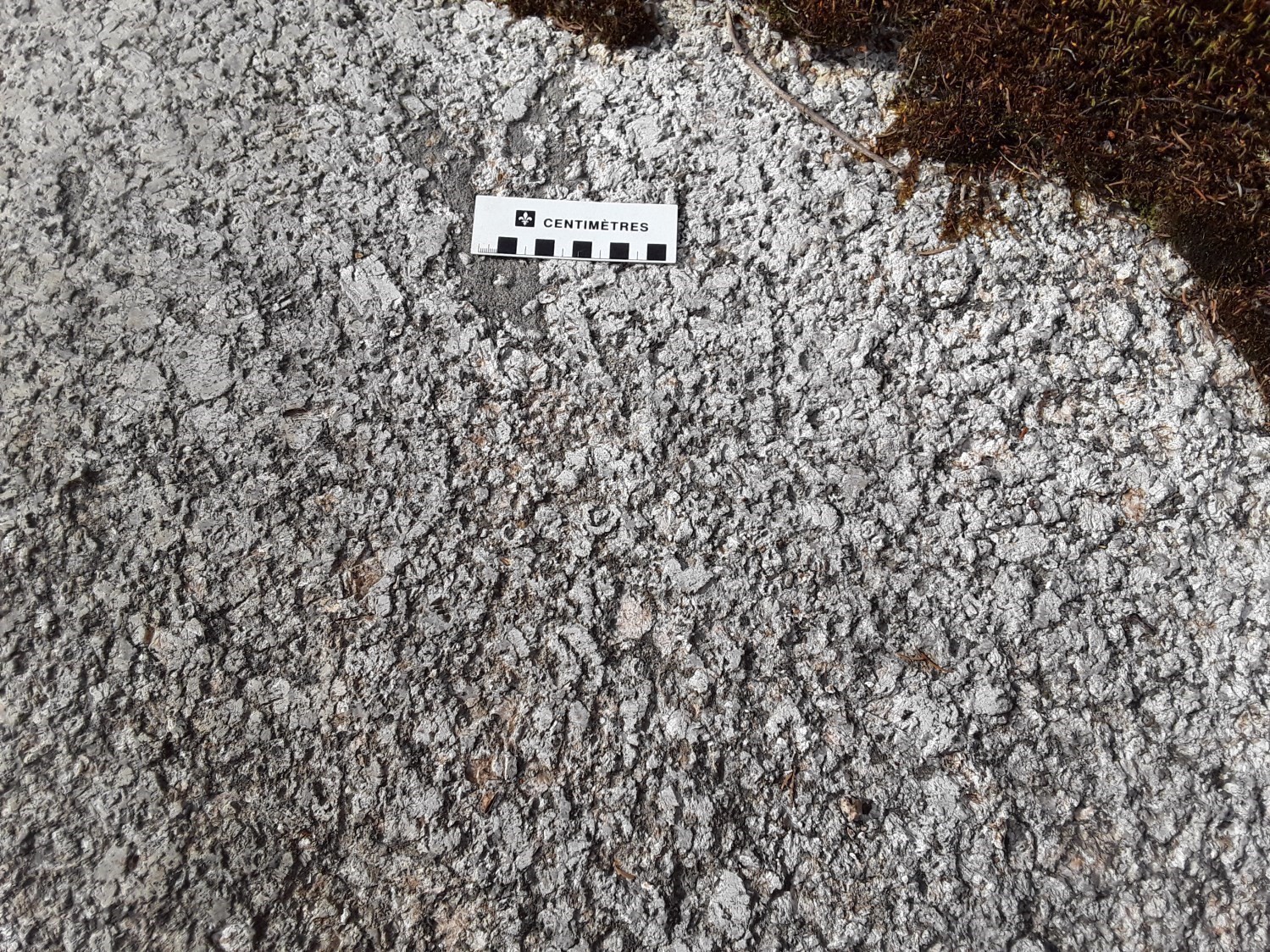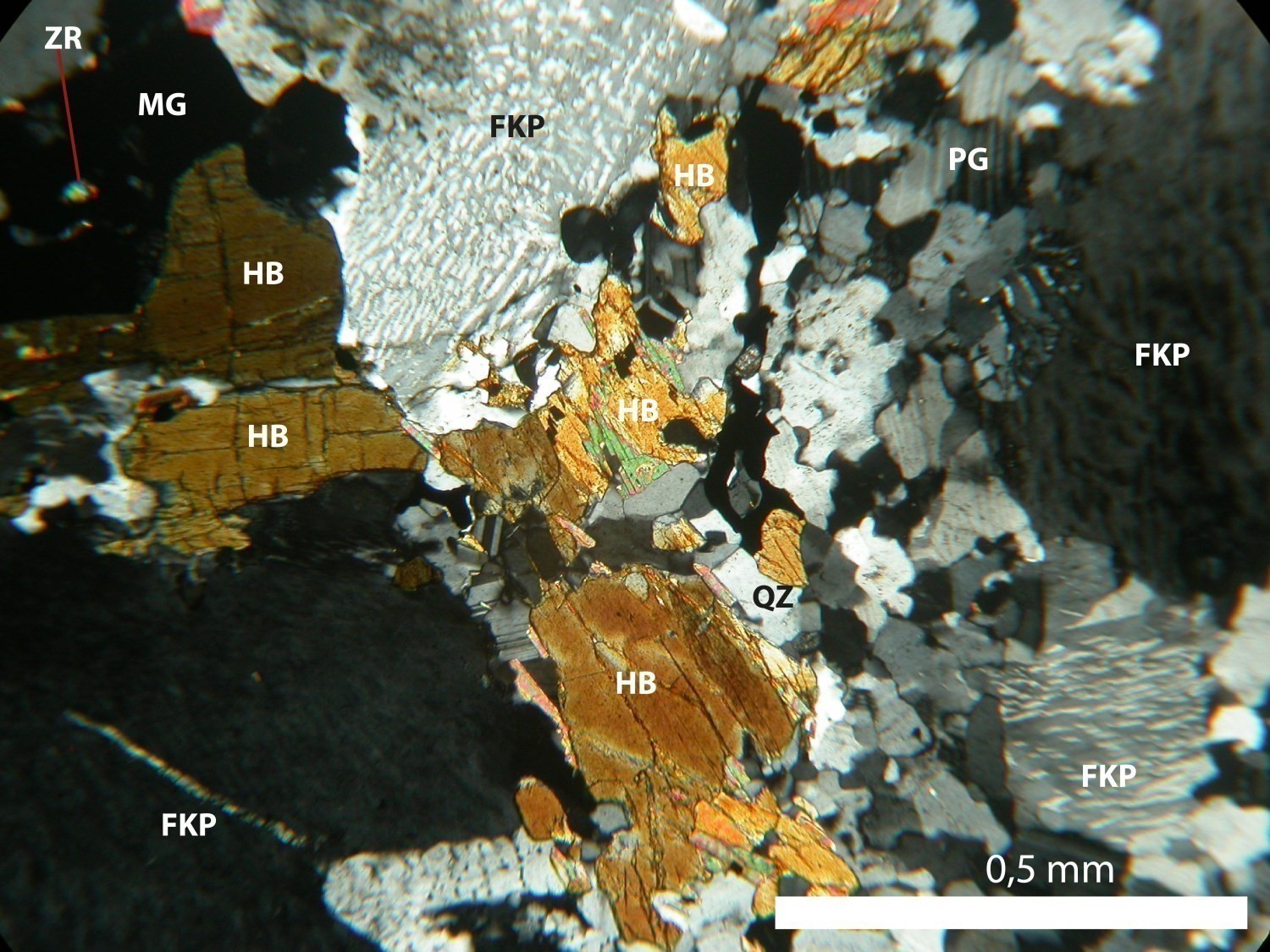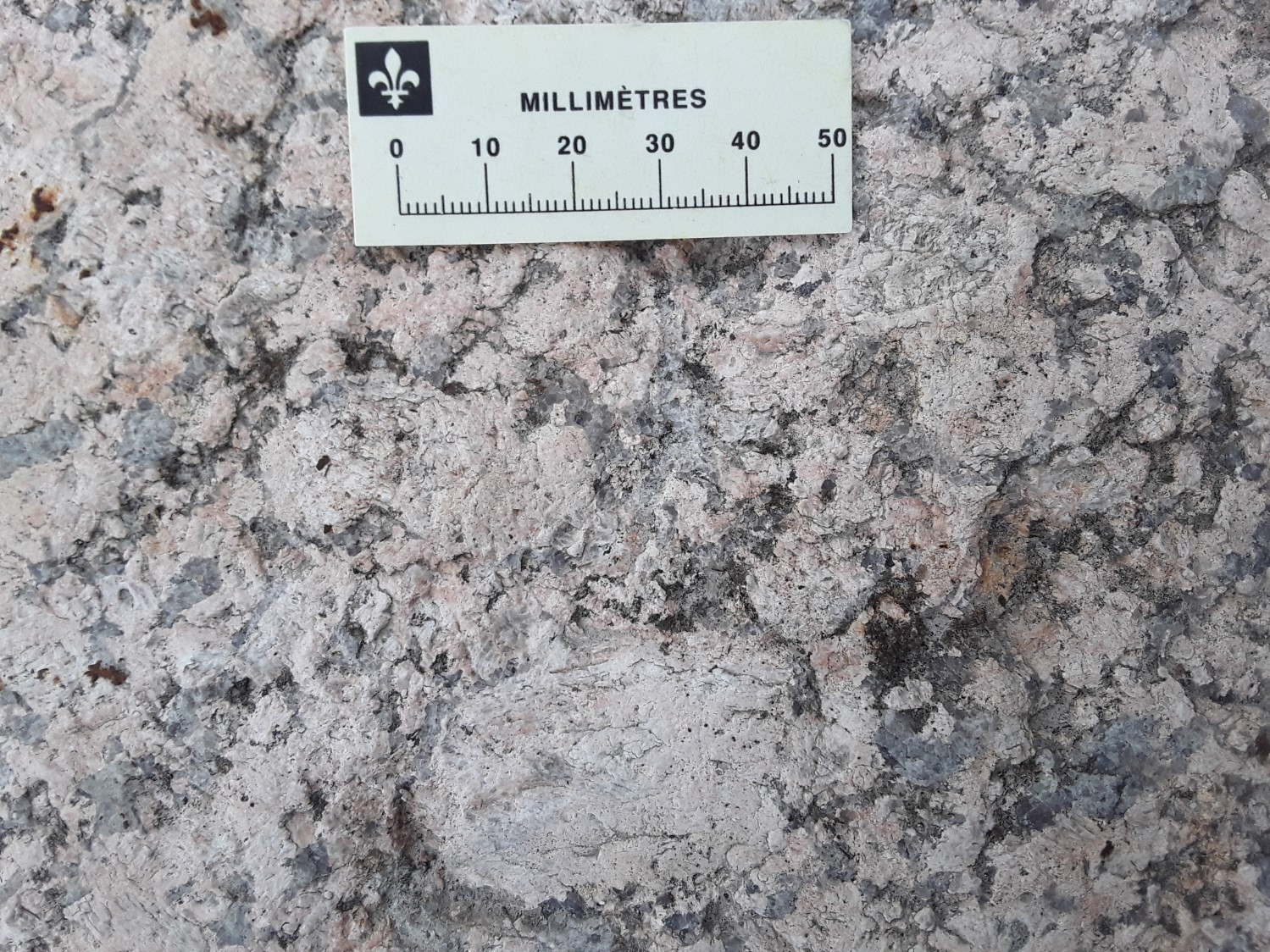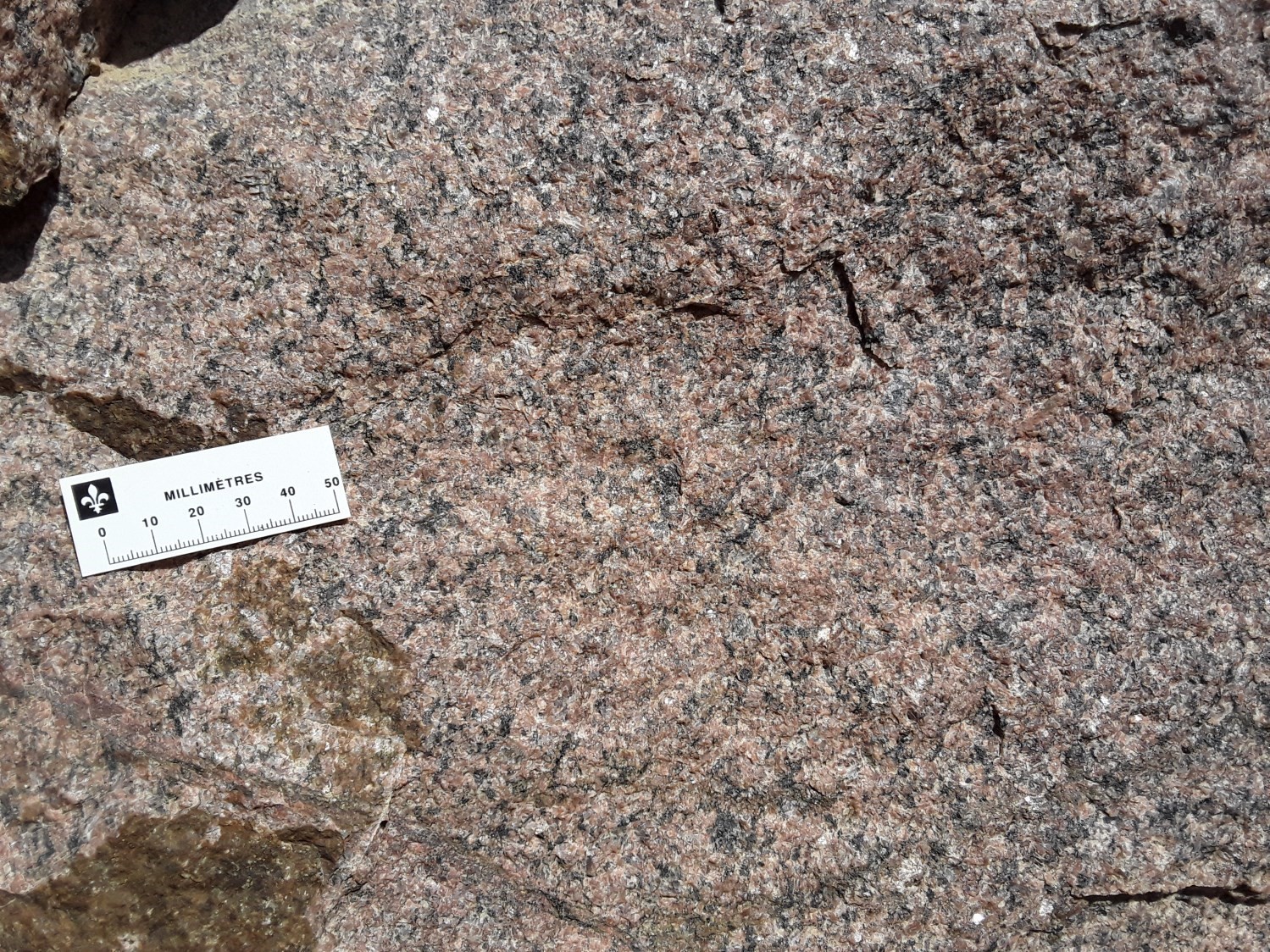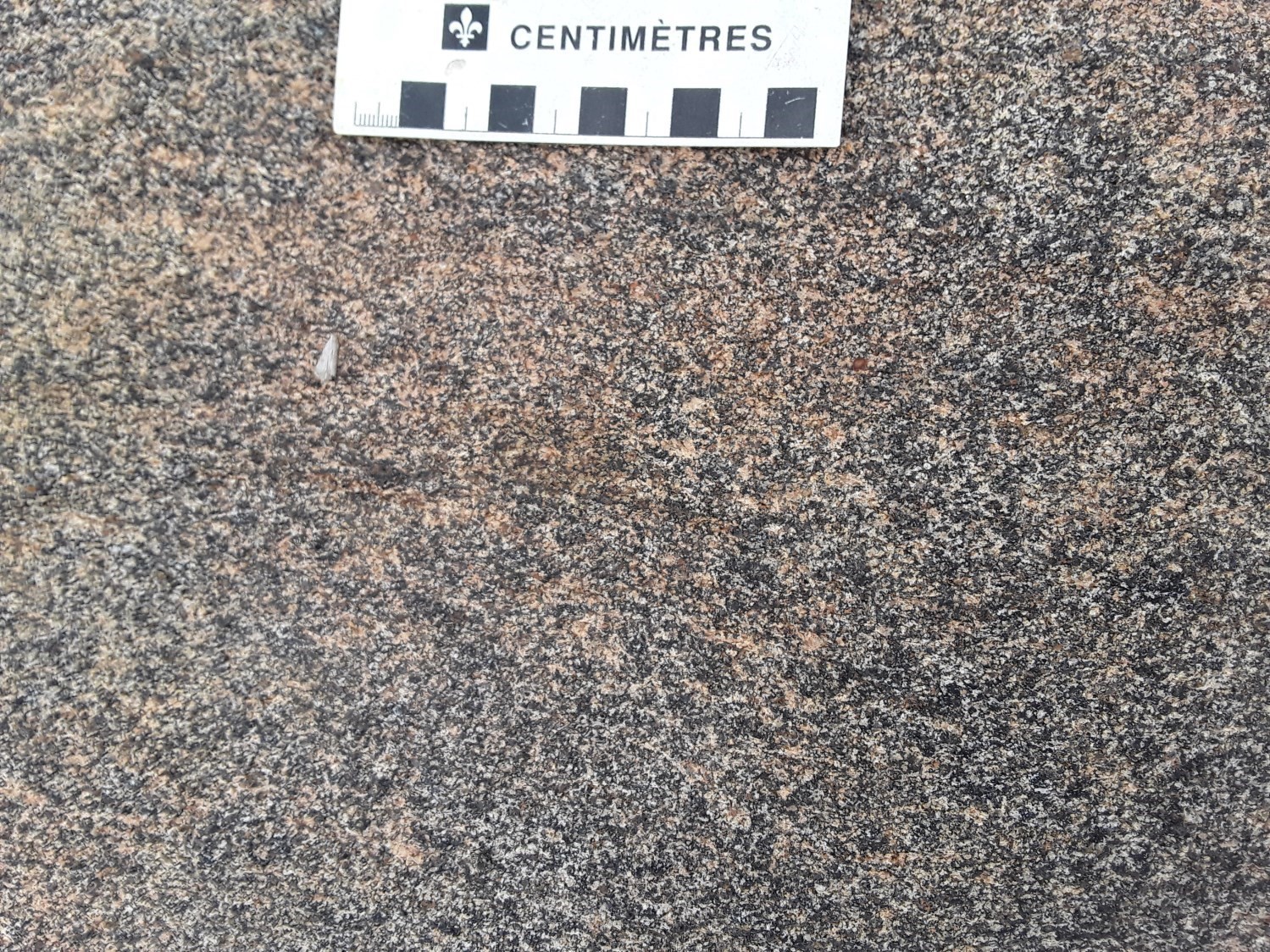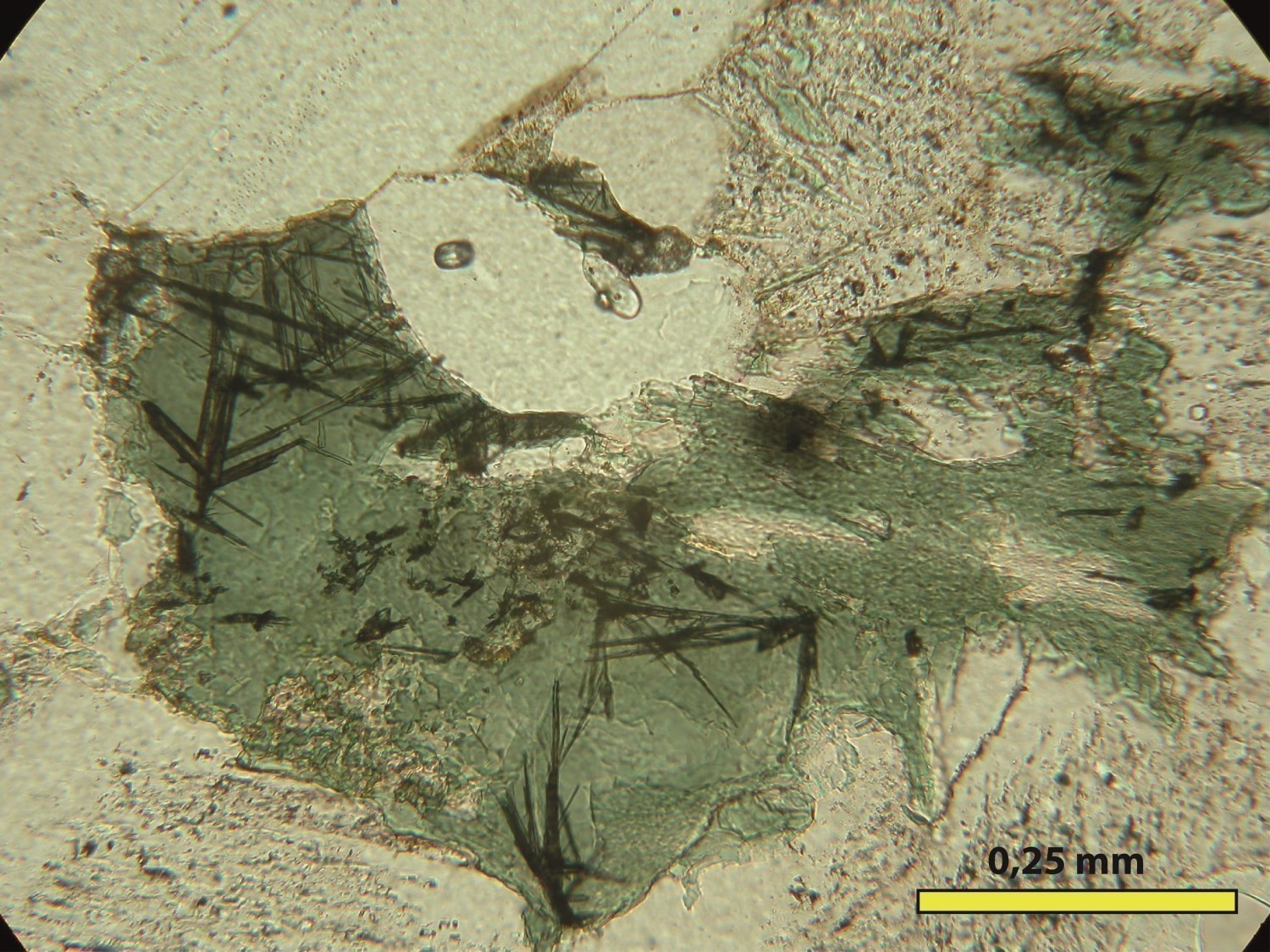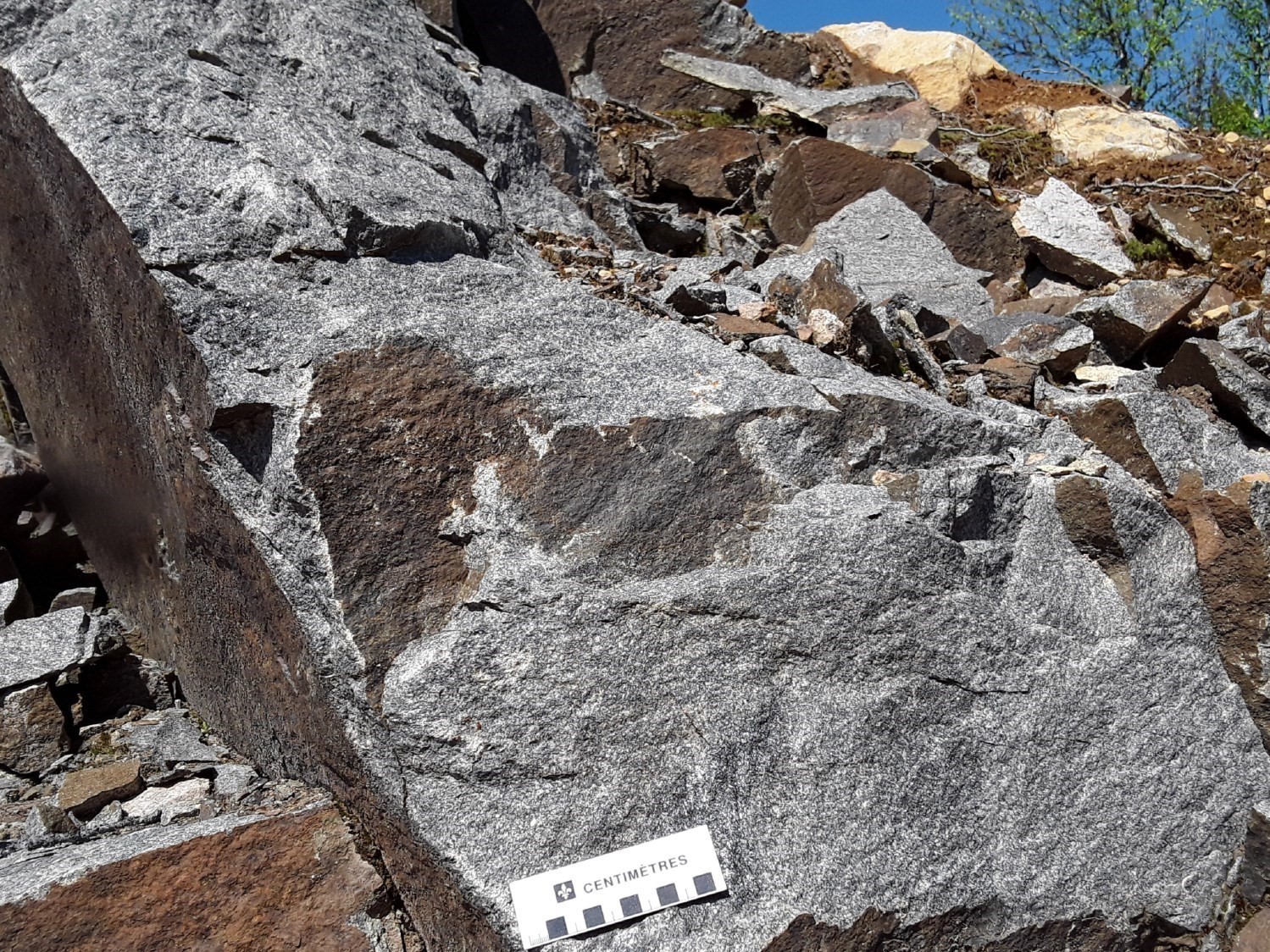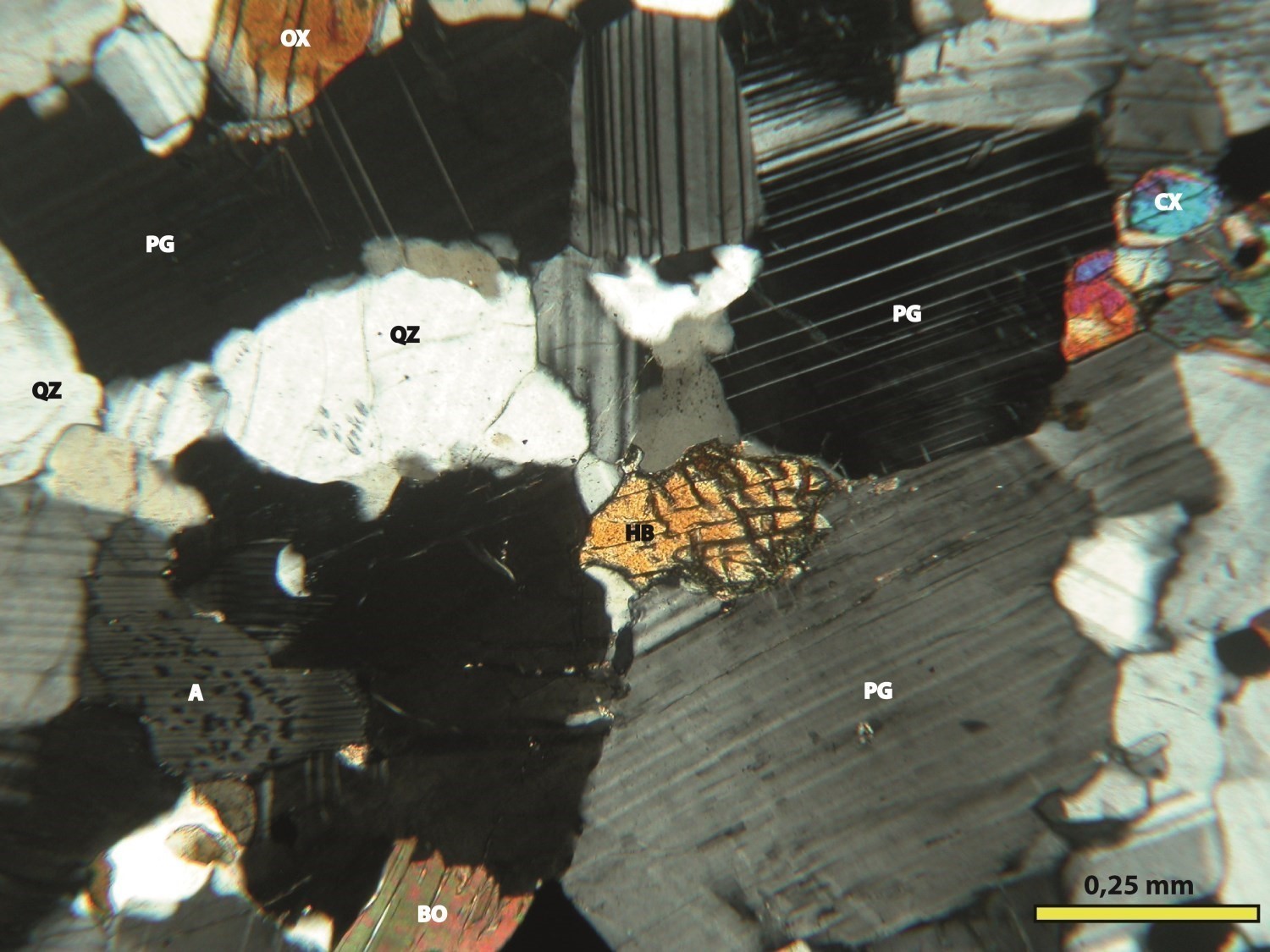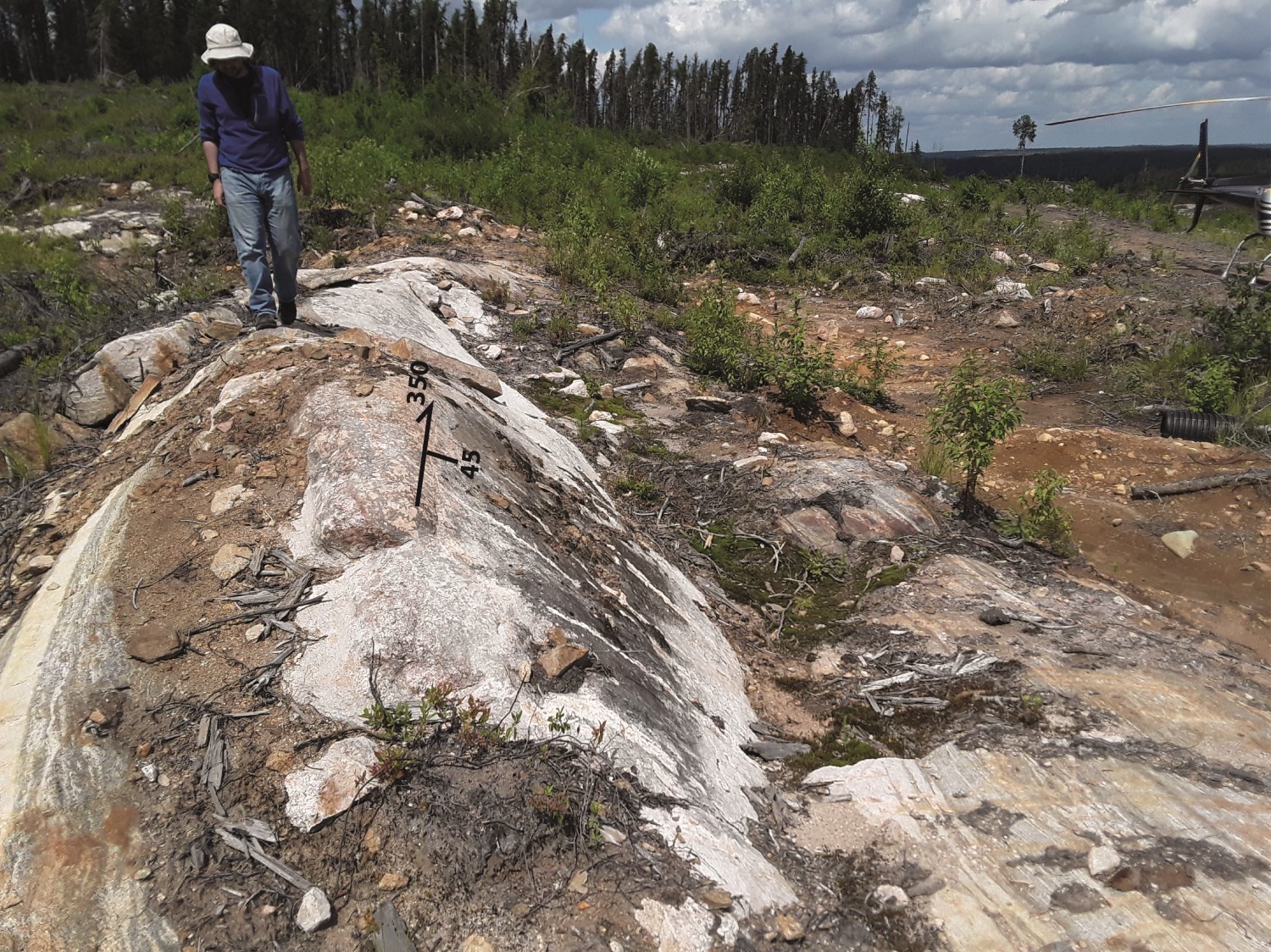
DISCLAIMER: This English version is translated from the original French. In case of any discrepancy, the French version shall prevail.
| Author: | Moukhsil and El Bourki, 2020 |
| Age: | Mesoproterozoic |
| Stratotype: | Type locality: Quarry Carrière de Saint-Thomas-Didyme; reference outcrop: 19-AM-186 |
| Type area: | Village of Saint-Thomas-Didyme area (central part of NTS sheet 32A15) |
| Geological province: | Grenville Province |
| Geological subdivision: | Allochton |
| Lithology: | Felsic, intermediate and mafic rocks |
| Category: | Lithodemic |
| Rank: | Suite |
| Status: | Formal |
| Use: | Active |
None
Background
The Saint-Thomas-Didyme Suite was defined by Moukhsil and El Bourki (2020) during geological mapping work in the Normandin–Saint-Félicien–Roberval area, in the Saguenay–Lac-Saint-Jean region (sheets 32A09, 32A10, 32A15 and 32A16). This suite was also mapped in sheet 32H02 in the Girardville region by Moukhsil and El Bourki (2021).
Description
The Saint-Thomas-Didyme Suite corresponds to a polyphase batholith consisting of quartz syenite, hypersthene quartz syenite, alkali feldspar granite, charnockite and smaller amounts of gabbronorite and quartz diorite. It is divided into two informal units: mPstd1 and mPstd2. These units are typically very magnetic and easily identifiable on aeromagnetic maps (Intissar and Benahmed, 2015).
Saint-Thomas-Didyme Suite 1 (mPstd1): Quartz Syenite, Hypersthene Syenite, Alkali Feldspar Granite, Locally Gabbronorite
Quartz syenite is pink in fresh exposure and whitish in altered patina. It is commonly K-feldspar porphyritic, which is generally perthitic. The rock is foliated and composed of large quartz zones, locally sericitized plagioclase, green hornblende in clusters aligned in foliation, opaque minerals (magnetite) and accessory minerals such as apatite and zircon. Quartz syenite contains centimetric alkali feldspar granite enclaves. Hypersthene syenite has the same composition as quartz syenite, except for an orthopyroxene content of 4-6%.
Alkali feldspar granite is pink in fresh exposure and altered patina. The rock is foliated, coarse grained, even grained or K-feldspar porphyritic (phenocrystals 1-3 cm long, locally up to 5 cm), which is generally perthitic. In thin section, granite contains quartz in large polygonal zones and has subgrains. Green hornblende forms clusters with magnetite and biotite. Apatite and zircon are the accessory phases. Locally, a gabbronoritic facies is observed and its relationship with other facies is not always well defined. Gabbronorite, grey-black in fresh and altered surfaces, contains plagioclase, pyroxene, biotite and magnetite. It is fine to medium grained and generally occurs as centimetric to metric boudins.
Saint-Thomas-Didyme Suite 2 (mPstd2): Mangerite, Gabbronorite, Charnockite, Alkali Feldspar Granite, Quartz Diorite
Mangerite is generally whitish in altered surface and greenish in fresh exposure, locally pinkish. It is characterized by a porphyritic texture defined by generally perthitic K-feldspar (15-20%, 1-3 cm long) and moderately to highly sericitized plagioclase phenocrystals. These feldspars are found in a medium to coarse-grained matrix composed of large quartz zones with undulatory extinction, green hornblende, biotite, orthopyroxene, and clinopyroxene and magnetite traces. Hornblende, biotite and magnetite form grain clusters that mark foliation. Apatite and zircon are the accessory phases. Quartz and feldspar contents are variable; therefore the lithology alternates between quartz syenite and mangerite.
Gabbronorite is generally grey-black and locally greenish in fresh and altered surfaces. The rock is fine to coarse grained and locally ophitic. In thin section, gabbronorite is composed of plagioclase displaying wide polysynthetic twinning, large green hornblende crystals, orthopyroxene, clinopyroxene, magnetite and a smaller amount of apatite. Green hornblende is more abundant than pyroxene. In outcrop, gabbronorite appears as the main lithology, or as centimetric to metric boudins.
Charnockite is grey-white in fresh exposure, grey-white to brown-grey (rust) in altered surface, medium grained and granoblastic. In thin section, it is composed of quartz with undulatory extinction, locally altered (iddingsite?) and uralitized (green hornblende) orthopyroxene, partially perthitic K-feldspar, plagioclase, magnetite, and trace biotite. Accessory phases are apatite, titanite and zircon. The myrmekitic texture is common. Locally, charnockite displays significant deformation, expressed as folding and early crenulation of the foliation.
Alkali feldspar granite is pink-grey in fresh exposure and brownish in altered patina. The rock is foliated, coarse grained, locally hematitized and K-feldspar (microcline) porphyritic or porphyroclastic (phenocrysts 1-2 cm long on average). In thin section, alkali feldspar granite contains quartz in large polygonal zones, very highly sericitized plagioclase, magnetite, trace amphibole, clinopyroxene and chloritized biotite. The latter contains needle rutile inclusions in the chlorite cleavage plane. Apatite and zircon are the accessory phases.
Quartz diorite is grey-black in fresh exposure and grey-white in altered patina. It is medium to coarse grained and contains large plagioclase crystals (70%), locally antiperthitic (<1%), large quartz zones (10%), hypersthene (3-6%), clinopyroxene (<2%), magnetite (8%), green hornblende (2-8%) and biotite (<1%). The presence of >5% hypersthene allows this rock to be classified in the hypersthene diorite family.
Thickness and Distribution
The Saint-Thomas-Didyme Suite outcrops mostly in sheet 32A15, in the form of a large, N-S elongated intrusion, with an area of ~330 km2.
Dating
Isotopic dating of a sample of alkali feldspar granite (outcrop 2019-AM-0186) yielded a Mesoproterozoic age.
| Unit | Sample Number | Isotopic System | Mineral | Crystallization Age (Ma) | (+) | (-) | Reference(s) |
| mPstd1 | 2019-AM-0186A | U-Pb | Zircon | 1042 | 12 | 12 | Papapavlou, 2020 |
Stratigraphic Relationship(s)
In the field, the Saint-Thomas-Didyme Suite intrudes into the Sainte-Hedwidge Intrusive Suite (in fault contact). It contains metric enclaves of the Barrois Complex and is intruded by several granitic pegmatite dykes.
Paleontology
Does not apply.
References
Publications Available Through SIGÉOM Examine
INTISSAR, R., BENAHMED, S. 2015. LEVE MAGNETIQUE AEROPORTE DANS LE SECTEUR OUEST DU LAC-ST-JEAN, PROVINCE DE GRENVILLE. MERN, GOLDAK AIRBORNE SURVEYS. DP 2015-06, 7 pages and 2 plans.
MOUKHSIL, A., EL BOURKI, M. 2020. Geology of the Normandin area, Grenville Province, Saguenay–Lac-Saint-Jean region, Quebec, Canada. MERN. BG 2020-01, 1 plan.
MOUKHSIL, A., EL BOURKI, M., 2021. Géologie de la région de Girardville, Province de Grenville, région du Saguenay – Lac-Saint-Jean, Québec, Canada. MERN; BG 2021-02, 1 plan.
PAPAPAVLOU, K., 2020. U-Pb geochronology report, Grenville 2019-2020. UQAM; MB 2020-09, 25 pages.
Suggested Citation
Ministère de l’Énergie et des Ressources naturelles (MERN). Saint-Thomas-Didyme Suite. Quebec Stratigraphic Lexicon. https://gq.mines.gouv.qc.ca/lexique-stratigraphique/province-du-superieur/suite-de-saint-thomas-de-didyme_en [accessed on Day Month Year].
Contributors
|
First Publication |
Abdelali Moukhsil, P. Geo., Ph.D. abdelali.moukhsil@mern.gouv.qc.ca; Mhamed El Bourki, GIT, M.Sc. mhamed.elbourki@mern.gouv.qc.ca (redaction) Mehdi A. Guemache, P. Geo., Ph.D. (coordination); Fabien Solgadi, P. Geo., Ph.D. (critical review); Simon Auclair, P. Geo., M.Sc. (editing); Céline Dupuis, P. Geo., Ph.D. (English version); Ricardo Escobar Moran (HTML editing). |


